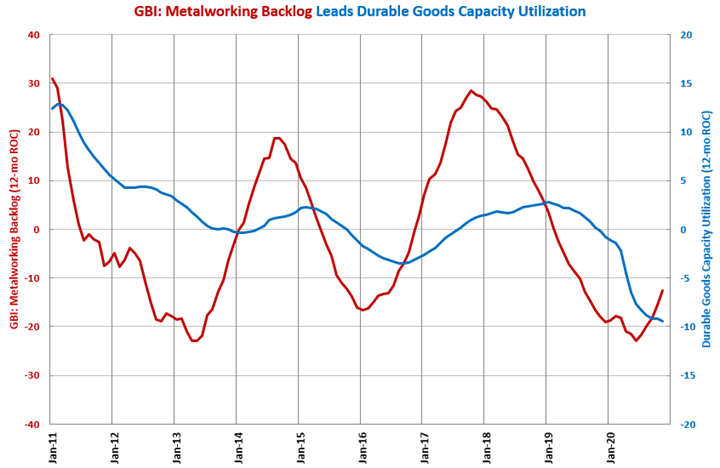Capacity Utilization Steadily Improving
Capacity utilization has improved every month since April. The annual rate of change in capacity utilization should bottom out any month now.
In November, durable goods capacity utilization was 72.1%, which was the fourth month in a row that the rate of capacity utilization was above 70% and the highest rate of capacity utilization since February. Compared with one year ago, capacity utilization contracted 4.4%, which ended a string of six straight months that the month-over-month rate of change contracted at a slower rate.
The annual change in durable goods capacity utilization contracted at an accelerating rate for the 13th month in a row, falling to -9.4% from -9.2%. November was the fastest rate of annual contraction since March 2010. As the annual rate of change tends to lead capital equipment consumption by seven-to-10 months, capacity utilization is signaling a bottom in the annual rate of change in capital equipment about the second quarter of 2021.
The GBI: Metalworking backlog index tends to lead the annual rate of change in capacity utilization by seven to 10 months. In September, the backlog index grew 16.4% compared with one year ago. This was the third straight month of accelerating growth and the fastest rate of growth since February 2018. The annual rate of contraction in the Backlog index reached a bottom in June and has contracted at a decelerating rate for five straight months, indicating that the annual rate of change in capacity utilization should see decelerating contraction for the next six to nine months.

Accelerating Growth:
Decelerating Growth:
Accelerating Contraction: aerospace, construction materials, durable goods, electronics/computers, forming/fabricating (non-auto), furniture, petrochemical processors, primary metals, printing, textiles/clothing/leather goods
Decelerating Contraction: automotive, custom processors, food/beverage processing, machinery/equipment, plastics/rubber products, wood/paper products




.JPG;width=70;height=70;mode=crop)
